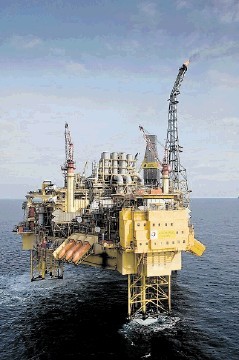
ON SUNDAY March 25, Total lost control of a rogue well in the Elgin-Franklin field complex, 240km (150 miles) east of Aberdeen, precipitating a crisis that will end up costing the French group billions of dollars in lost revenues but which has so far not cost any lives.
The episode started a month earlier when it was realised that the redundant G4 production well was behaving oddly; over-pressuring.
A well-kill was attempted – fairly standard practice in this sort of situation. In the case of G4, Total’s plan is that plugging and abandonment will follow the kill. The presumption is that the Health and Safety Executive was advised of the difficulty.
The twist that no-one was prepared for was the fact that gas from a “tight” rock formation some 4,000m below the seafloor had penetrated the well annulus (cavity) as the result of a structural failure during the attempted kill and was making its way to the wellhead platform via conductor pipework.
At a major press conference on March 30, the company categorically denied that gas was bubbling up through the sea beneath the wellhead platform, despite claims by offshore personnel.
The failure resulted in the kill team losing control of the well, gas/condensate started to spew and the company swiftly started an evacuation which, fortunately, went like clockwork. Initially, a few personnel stayed though they too were subsequently taken off as the gas cloud grew.
Though the installations were “powered down” to eliminate sources of ignition, it later emerged that the gas flare remained lit.
It is lucky for Total that the weather had been excellent and that winds have so far been blowing the gas clear of the installations. But for how many days longer was the question being asked. Then came divine intervention – the flare extinguished naturally that same day (March 30).
So, for how many more days will millions of cubic feet of flammable gas spew from the faulty well?
No one knows. Arguably, all systems feeding gas to the flare should have been purged as part of the abandonment process. But hindsight is a great teacher.
The challenge now is to stabilise G4 safely. As has been reported, there are two basic options . . . kill the well with very heavy mud, or drill one or more relief wells to the location where the carbon-steel outer well wall is damaged. One option will take many weeks, the other many months. Both will be dangerous and very expensive.
Wind the clock back to the terrible night of July 6, 1988, when the Piper Alpha oil platform blew up and 167 offshore workers perished.
Billions of pounds were spent by a complacent industry caught with its pants down. If it wasn’t the Piper platform that blew up, it would have been another.
The Cullen Inquiry exposed a laxity that I still find hard to believe and the companies knew it; witness the huge sums spent on safety, even before Cullen’s findings were published.
There have been various incidents since, such as the oil leak at Shell’s Gannet platform last year; and there are times when the Step Change safety initiative has struggled, yet I believe that the North Sea is safer than it once was.
Total’s disaster, for that is what it is despite the safe evacuation at Elgin-Frankin, must be regarded as a wake-up call to the North Sea industry lest complacency be creeping back.
Bearing in mind that its policing track record has been queried too, the HSE must henceforth be ultra-vigilant in its mission to ensure a safe, pollution-free North Sea.
And don’t forget, Brussels is looking for any excuse to grab control of UK offshore and the Elgin crisis could prove to be the tipping point.